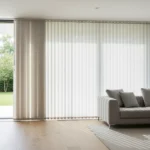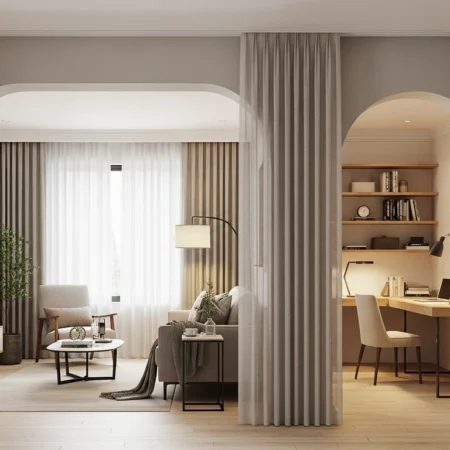Creating distinct areas in a small space often feels like trying to fold a fitted sheet — possible, but oddly complicated. The good news? You can craft beautiful, functional zones without adding walls or losing precious square footage. With the right dividers, your home can feel calmer, clearer, and surprisingly larger. These creative ideas help you shape boundaries with style, intention, and a touch of personality.
1. Use a Backless Shelf as a See-Through Divider

A backless shelf adds structure without blocking light. You gain storage, display space, and an airy sense of separation. It’s one of the easiest ways to divide a living room from a bedroom in a studio.
2. Install a Slim Glass Partition

A slim framed-glass partition creates a distinct room while maintaining brightness. If you love clean lines and modern aesthetics, this option adds polish without visual heaviness.
3. Hang Floor-to-Ceiling Curtains

Curtains introduce softness and flexibility. Open them for a spacious feel, close them for privacy — or leave them partially drawn for a gentle, dreamy divide.
4. Use a Folding Screen That Adds Texture

A folding screen functions as a divider and a sculptural piece of décor. Choose one with woven fibers, carved wood, or fabric panels to introduce instant visual interest.
5. Add a Plant Wall or Tall Potted Greenery

Plants offer one of the most uplifting ways to define zones. A row of tall plants or a vertical plant wall can carve out areas while filtering light through leaves.
6. Build a Low Half Wall for Subtle Separation

A low half wall quietly announces boundaries without closing the room. It works beautifully between a kitchen and living area, allowing conversation and light to flow freely.
7. Use a Console Table Behind a Sofa

A narrow console behind the sofa creates a soft division and offers space for lighting, trays, or décor. It’s ideal for forming a walkway or marking an entry zone.
8. Try Sliding Barn Doors or Panel Doors

Sliding doors give you the ability to open or close a space as needed. They add architectural charm and save the swing space that traditional doors require.
9. Use a Raised Platform to Define a Zone

Elevation creates distinction. A raised platform can transform a bed area, office nook, or reading corner into its own world without adding any vertical barriers.
10. Create Zones with a Statement Rug

A rug may not be a wall, but it behaves like one. With the right size and placement, a rug anchors a specific area and visually separates one function from another.
11. Position Your Desk as a Divider

A desk can define a workspace and act as a subtle partition. When placed strategically between two zones, it forms both a boundary and a productive hub.
12. Use an Open Wardrobe or Clothing Rack

In a small bedroom or studio, an open wardrobe can double as storage and separation. Style it neatly and it becomes a chic semi-transparent divider.
13. Create a Divider with Pendant Lights

Lighting draws invisible lines. Hanging pendant lights above a dining table, reading area, or work zone visually distinguishes that section of the room.
14. Try a Multi-Directional Bookcase Divider

A bookcase with cubbies that face different sides allows each zone to use the divider in its own way. It’s a functional hero in open-concept layouts.
15. Use a Curtain-Framed Canopy Bed

A canopy bed with soft curtains forms a private nook without using actual walls. In studios, this creates a dreamy retreat that doesn’t overwhelm the room.
Closing Summary
Small-space dividers do more than split a room — they shape your daily experience. With thoughtful choices, you can create calm corners, productive zones, and cozy retreats without ever losing openness. When a space reflects who you are and how you live, even the smallest home can feel wonderfully expansive.










